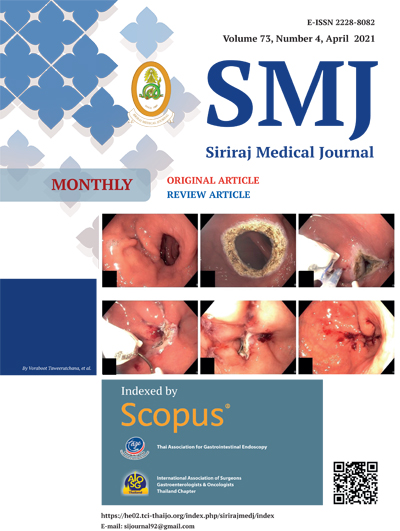Costs per DALYs Averted of Quadrivalent Influenza Vaccine versus Trivalent Influenza Vaccine in Elderly Population in Thailand
DOI:
https://doi.org/10.33192/Smj.2021.34Keywords:
Cost-effectiveness, DALYs averted, Influenza vaccine, Influenza, Trivalent Influenza Vaccine, Quadrivalent Influenza VaccineAbstract
Objective: Influenza is an infection of the respiratory system with a high annual incident rate. Influenza vaccine
can reduce the severity of influenza and prevent transmission of the virus. Influenza vaccines in Thailand are the
Trivalent Influenza Vaccine (TIV) and the Quadrivalent Influenza Vaccine (QIV). The cost and the effectiveness of
the QIV in preventing transmission of the virus are greater than the TIV. Until now, no studies have been conducted
to compare the economic impact of using QIV or TIV. This study aimed to evaluate the economic effects of using
QIV versus TIV in Thai populations age 60 years and over.
Materials and Methods: The study was carried out from a societal perspective for cost per DALYs averted. A decision
tree model was used to analyse the costs and DALYs averted of Thais after they received the vaccine.
Results: In a period of one year, it was found that in Thais age 60 years and over, the total cost of TIV was 2,445.19
baht with 0.0094 DALYs and total cost of the QIV was 2,629.28 baht with 0.0082 DALYs and the incremental costeffectiveness
ratio (ICER) of the QIV was 158,489.24 baht per DALYs averted. The acceptability curves demonstrated
that the probability of QIV being cost-effective was 95% of the willingness to pay, being 1.2 times the Thai gross
national income per capita.
Conclusion: Therefore, in Thai people age over 60 years and over, QIV is more cost-effective than TIV. The results
of this study can be used by policymakers to help inform their decisions about which influenza vaccine is more
cost-effective.
Downloads
Published
How to Cite
Issue
Section
License
Authors who publish with this journal agree to the following conditions:
Copyright Transfer
In submitting a manuscript, the authors acknowledge that the work will become the copyrighted property of Siriraj Medical Journal upon publication.
License
Articles are licensed under a Creative Commons Attribution-NonCommercial-NoDerivatives 4.0 International License (CC BY-NC-ND 4.0). This license allows for the sharing of the work for non-commercial purposes with proper attribution to the authors and the journal. However, it does not permit modifications or the creation of derivative works.
Sharing and Access
Authors are encouraged to share their article on their personal or institutional websites and through other non-commercial platforms. Doing so can increase readership and citations.















